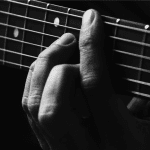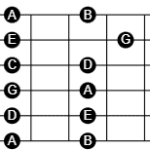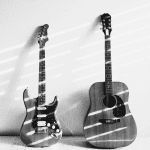

If you’ve only picked up the three string guitar recently and you’re a little stumped, don’t worry, you’re not alone! A friend of my wife makes three string guitars out of various things (not just cigar boxes) and she got me one more than a few years ago. If took a few false starts before everything just clicked and I figured out what guitar knowledge to apply and what to approach differently.
What’s In A Name?
Before I go further, let’s clarify naming conventions. I prefer the term “three string guitar” rather than cigar box guitar. Why? Well, many cigar box guitars have four strings. Some only have two. Hell, some have all six.
Commonly, yes, a cigar box guitar will only have three strings. And yes, commonly a three string guitar will be made out of a cigar box. But not always! The terms three string guitar and cigar box guitar are fairly interchangeable. But just be aware.
And obviously the reason a cigar box guitar is called that is because it’s made out of a cigar box! In this case, the cigar box acts as a resonating chamber, the same way the body of an acoustic guitar behaves. Anything else will work though, as long as it’s hollow. I’ve seen guitars made out of old buckets and various tubs. I’ve even seen them made out of oil cans. You can also get solid or semi-hollow body three string guitars made out of various materials.
Three String Guitar Tuning


While guitar standard tuning is E-A-D,-G-B-E, things can change on the three string. D-A-D is pretty common, as is G-D-G. Both of these marry up fairly well with standard guitars. But, depending on the scale length of the three string, it may be tuned in some other 1-5-1 arrangement.
While guitar standard tuning has its own intrinsic sense, so does the three string’s. Firstly, this 1-5-1 tuning allows you to play a power chord as a barre up and down the neck. If you’re stuck, just move up and down. It also makes it easy to add a third or a minor third to the chord, as well as 7ths. The 1-5-1 tuning is also symmetrical, so chord shapes work if you reverse the highest and lowest string. This can be nice for chord inversions and slash chords.
You can strum a three string guitar just like you strum a standard guitar, but obviously it doesn’t sound as full. Regardless, it’s still good to know your three string guitar chord shapes. I have a separate article on that, so follow the link.
Note Finding On The Three String Guitar
I cover much of this in my chords for three string guitar lesson, but it’s just as important in a getting started article as well. By now, you’re probably pretty good at note finding on the six string guitar, so just use the same strategies that work for you.
What works for me is reference notes. If you’re playing a chord, you know where the one, the five, and the octave are. You can then move up and down from there.
Obviously scales are different on the three string guitar, but, despite some shifting to get all degrees of the scale, there’s actually not a lot of movement if you don’t worry about playing the fourth. Here’s a diagram with the 7th highlighted since you can play it in two different places.


It gets even easier if you’re playing the blues, since it’s hard to hit a bad note. Check out everywhere you can find a flat 3rd, 5th, or 7th.


For me, as someone who doesn’t often stray away from standard tuning, understanding the new tuning of the three string guitar was one of the biggest hurdles. But once I sat down and mapped it all out, it was eye opening.
Blues Comping On The Three String Guitar
Ultimately, the three string guitar is best for Blues based music, and a simple blues comp is super easy.
When playing on the lowest string, realise that the next string is the fifth, so you can get an easy blues comp by strumming the two open low strings then by fretting the second fret on the middle string. That’s your basic Blues rhythm that you can build everything else on.
Drone Notes On The Three String Guitar
The three string guitar also lends itself well to drone notes. You can play melodies or chordal fragments across two of the strings while droning away on the third one.
If you check out the three string guitar chords article, you’ll also notice that it’s common to play the root of a chord on the middle string. This means that on a standard Blues that may go something like I-IV-I-V-IV, you don’t actually have to shift positions that much. Take a look at the following two diagrams:




If you play these two shapes in the same position, for example the fifth fret, you’re switching quickly from the one chord to the five chord. Obviously shifting the second figure back a fret is the four chord. There’s some easy Blues right there!
If you’re only going to learn two chord shapes on the three string guitar, make it those two.
Combining Comping, Drones, And Chords On The Three String Guitar
I just lied a little bit. After you learn the two above chord shapes, learn 7th chords on the three string guitar as well, at least the first two shapes in the below.






Combining these shapes, along with the above chord shapes allows for easy strumming, easy plucking, droning, and even shifting into a basic Blues comp.
While three string guitar playing is less about strumming chords, when I was first getting started, I found it easier to play around chord shapes, doing arpeggios and simple melodies.
I encourage you to take a look at my longer article on three string guitar chords, but the five shapes listed here are a good start without stretching your brain too much. Fooling around with these should get you through a number of great Blues standards and make it feel like you’re actually playing.
What kind of music are three string guitars good for?
I’ve already said it, but the three string works best in Blues and general Blues based music, but don’t let that stop you from branching out a little bit. Try some Country or Bluegrass as well, and even some rock riffs. If you get more confident, chuck on a slide too. My electric three string really wails through some light overdrive. While it can sound a little thin at times, adding some reverb for depth can also be a good idea.
This article is one the bare bones basics of the three string guitar. I’ve found resources on the instrument to be relatively thin, with little discussion of theory. I’m a firm believer that an understanding of the instrument will lead to more skill and enjoyment, rather than just showing you how to do it. So, now that you have the basics, play around a little bit. Start with your favourite Blues tunes then go from there.
Related posts:





















